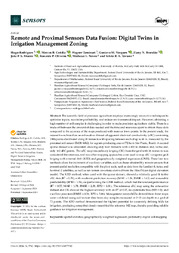Remote and proximal sensors data fusion: digital twins in irrigation management zoning.
Remote and proximal sensors data fusion: digital twins in irrigation management zoning.
Autoria: RODRIGUES, H.; CEDDIA, M. B.; TASSINARI, W.; VASQUES, G. M.; BRANDAO, Z. N.; MORAIS, J. P. S.; OLIVEIRA, R. P. de; NEVES, M. L.; TAVARES, S. R. de L.
Resumo: The scientific field of precision agriculture employs increasingly innovative techniques to optimize inputs, maximize profitability, and reduce environmental impact. However, obtaining a high number of soil samples is challenging in order to make precision agriculture viable. There is a trade-off between the amount of data needed and the time and resources spent to obtain these data compared to the accuracy of the maps produced with more or fewer points. In the present study, the research was based on an exhaustive dataset of apparent electrical conductivity (aEC) containing 3906 points distributed along 26 transects with spacing between each of up to 40 m, measured by the proximal soil sensor EM38-MK2, for a grain-producing area of 72 ha in São Paulo, Brazil. A second sparse dataset was simulated, showing only four transects with a 400 m distance and, in the end, only 162 aEC points. The aEC map via ordinary kriging (OK) from the grid with 26 transects was considered the reference, and two other mapping approaches were used to map aEC via sparse grid: kriging with external drift (KED) and geographically weighted regression (GWR). These last two methods allow the increment of auxiliary variables, such as those obtained by remote sensors that present spatial resolution compatible with the pivot scale, such as data from the Landsat-8, Aster, and Sentinel-2 satellites, as well as ten terrain covariates derived from the Alos Palsar digital elevation model. The KED method, when used with the sparse dataset, showed a relatively good fit to the aEC data (R2 = 0.78), with moderate prediction accuracy (MAE = 1.26, RMSE = 1.62) and reasonable predictability (RPD = 1.76), outperforming the GWR method, which had the weakest performance (R2 = 0.57, MAE = 1.78, RMSE = 2.30, RPD = 0.81). The reference aEC map using the exhaustive dataset and OK showed the highest accuracy with an R2 of 0.97, no systematic bias (ME = 0), and excellent precision (RMSE = 0.56, RPD = 5.86). Management zones (MZs) derived from these maps were validated using soil texture data from clay samples measured at 0–10 cm depth in a grid of 72 points. The KED method demonstrated the highest potential for accurately defining MZs for irrigation, producing a map that closely resembled the reference MZ map, thereby providing reliable guidance for irrigation management.
Ano de publicação: 2024
Tipo de publicação: Artigo de periódico
Unidade: Embrapa Solos
Observações
1 - Por padrão são exibidas publicações dos últimos 20 anos. Para encontrar publicações mais antigas, configure o filtro ano de publicação, colocando o ano a partir do qual você deseja encontrar publicações. O filtro está na coluna da esquerda na busca acima.
2 - Para ler algumas publicações da Embrapa (apenas as que estão em formato ePub), é necessário ter, no celular ou computador, um desses softwares gratuitos. Sistemas Android: Google Play Livros; IOS: iBooks; Windows e Linux: software Calibre.
Acesse outras publicações
Acesse a Base de Dados da Pesquisa Agropecuária (BDPA) para consultar o acervo completo das bibliotecas da Embrapa.

